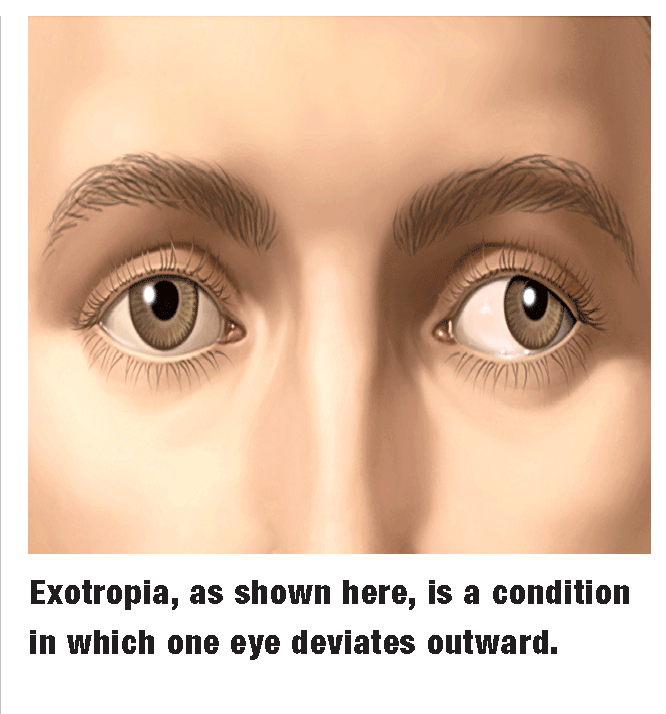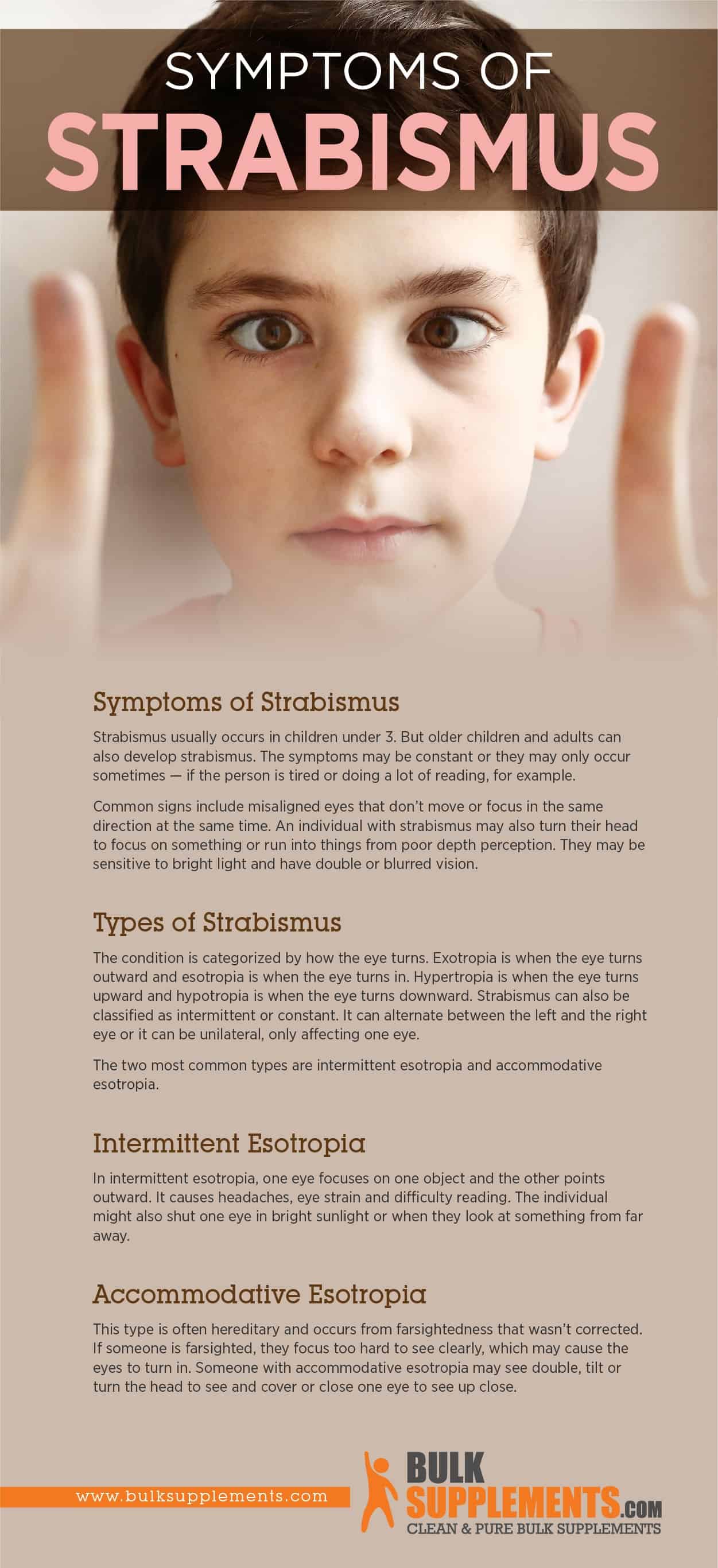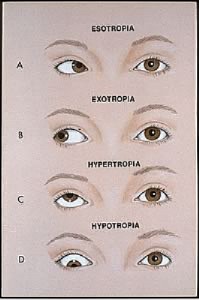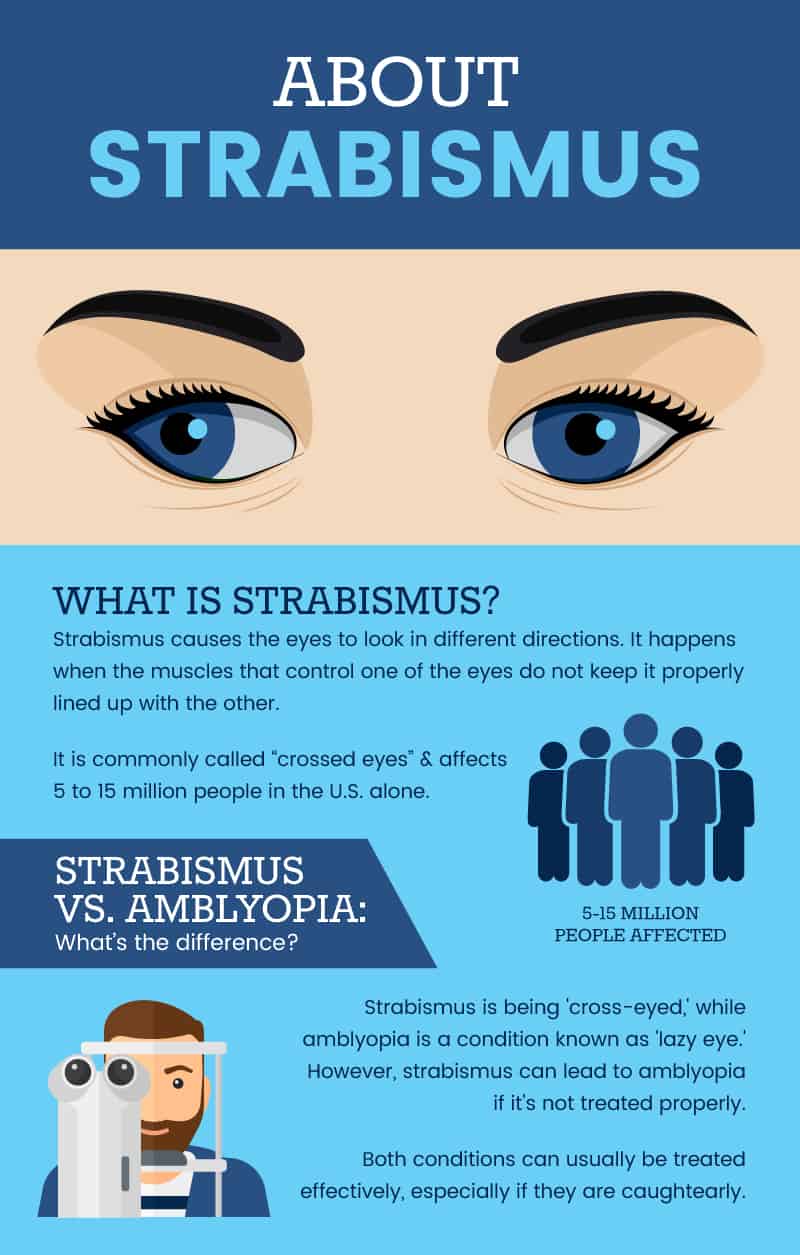70以上 exotropia eye vision 217037
Exotropia is an outward turning of one or both eyes It is a common type of strabismus About a quarter of all children with strabismus have exotropia There are different types of exotropia The condition can be visually noticeable either all the time or just sometimesThe eye may be turned in (this is called esotropia), turned out (exotropia), looking upward (hypertropia), or looking down (hypotropia) Strabismus can be treated, and the earlier the betterBackground Intermittent exotropia (IXT) is the most common form of childhood exotropia 1, 2 with an incidence of 321 per 100,000 in children under 19 years of age 1 The strabismus is characterized by an exodeviation of one eye that is interspersed with periods of ocular alignment 3 Reliable measurement of the deviation is often hindered by the variable nature of the strabismus,

Management Of Squint With Near Distance Angle Disparity Eye News
Exotropia eye vision
Exotropia eye vision-If a person has sensory exotropia, the eye may suffer from poor vision or blindness It will also turn outward Initially, if an infant or young child has a blind or poorly seeing eye, esotropia (crosseyes) develops However, in older children (between the ages of 2 and 4 years), the eye often becomes exotropicChildhood exotropia (outward deviation) is a horizontal exodeviation characterised by visual axis forming a divergent angle It usually begins as exophoria Exophoria is a condition in which eyes are straight without deviation when both eyes are open However, eye under cover deviates on coveruncover test or alternate cover test It may progress to exotropia which




Capella Eyecare Exotropia Strabismus Is A Condition In Which One Eye Is Looking Straight And The Other Eye Is Turned Inward Outward Upward Downward As You Can See From This Photo
Exotropia in an eye with poor vision is called sensory exotropia In this case, the eye with low vision is unable to work together with the other eye, and therefore, the poorly seeing eye may tend to drift outward and take over Sensory exotropia may occur at any age Of course, if the visual problem is treatable, it should be addressed as soonIntroduction Intermittent exotropia is the most common form of strabismus, characterized by an intermittent outward deviation of the eyes, affecting as much as 1% of the population 1,2 This condition most often presents in childhood and affects females more than males Control of the intermittent deviation can vary throughout the day 3,4Sensory exotropia Poor vision in the eye causes it to turn outward and not work in tandem with the straight eye This type of exotropia can occur at any age Acquired exotropia
Exotropia Exotropia, commonly called wandering eye or walleye, is the visual condition in which a person uses only one eye to look at an object while the other eye turns outward Exotropia is one of several types of strabismus, a condition resulting in eye turns or deviating eyes This condition usually does not involve faulty or damaged eyeSchedule eye exams for crossed eyes, strabismus, Esotropia, ExotropiaNJ Pediatric OphthalmologistThe Eye Care &If the eye is turned out all the time, it is called exotropia Children with intermittent exotropia have a strong tendency to let the eye turn out, but it does not turn out all the time When the child does control the eye alignment, the eyes are straight and function normally together Exotropia occurs in about 1 out of 100 children
Congenital exotropia Also known as infantile exotropia People with this condition have an outward turning of the eye or eyes from birth or early childhood Sensory exotropia – Poor vision in the eye causes it to turn outward and not work in tandem with the straight eye This type of exotropia can occur at any ageVision therapy is often and effectively used for strabismus (commonly called esotropia or exotropia) If you have eyes that do not properly work together, you may have had eye surgery Unfortunately for many, eye surgery is not always effective in treating strabismusEsotropia symptoms Here are some of the symptoms patients may experience with esotropia Eyes turning inwards, presenting a blurry and distorted view Both eyes crossing inwards Developing amblyopia or a lazy eye – a condition that involves one eye receiving weaker brain signals, subsequently causing it to become 'lazy' in response




Exotropia Outward Eye Turn




Crossed Eyes Strabismus Optometrist In Burbank Eye Care Center Limited
It's actually more common now than it used to be Exotropia can occur intermittently or be constant You can read all about it below, as well as watch Dr Julie go into great detail in thisSurgery CenterWestfieldWarrenIselin, an affiliate of Prism Vision GroupExotropia in an eye with poor vision is called sensory exotropia In this case, the eye with reduced vision is unable to work together with the other eye, and therefore, the poorly seeing eye may have a tendency to drift outward Sensory exotropia may occur at any age




Figure 11 Vision Screening Essentials Screening Today For Eye Disorders In The Pediatric Patient American Academy Of Pediatrics




Strabismus
What is Exotropia Exotropia, a form of Strabismus, is the outward deviation (turn) of an eye and occurs in 12% of children by 7 years of age and occurs equally in males and femalesIn exotropia, one or both eyes turn out What are the symptoms The person's eye orExotropia — a common type of strabismus — is the outward deviation of an eye (away from the nose) The deviation or eye turn may occur while fixating (looking at) distance objects, near objects or both When the eye turns outward at all distances and at all times, it is called constant exotropiaBottom line Be sure to get a thorough eye examination before you start a vision treatment plan Pencil pushups This is a handy exercise for exotropia Draw three barrels of progressive size



The Basics Of A Strabismus Exam




3 Eye Exercises For Strabismus Healthline
Intermittent exotropia is a very common type of eye misalignment One or both eyes turn out toward the ear occasionally Only one eye turns out at a time while the other eye points straight forward Cause of intermittent exotropia The cause of this condition is not known Most experts believe that the brain of affected patients has trouble controlling theDefinition Exotropia (also known as walleyes) is a form of strabismus where the eyes are deviated outside It is the reverse of esotropia People with exotropia typically experience crossed diplopia Intermittent exotropia is a fairly typical condition "Sensory exotropia" takes place in the existence of bad visionKeep in mind that a vision screening is not an adequate replacement of a comprehensive examination or assessment of an individual's ocular posture An exotropia is an outward eye turn that can have a large variety of presentations It can be intermittent, constant, unilateral, alternating and vary in magnitude




Capella Eyecare Exotropia Strabismus Is A Condition In Which One Eye Is Looking Straight And The Other Eye Is Turned Inward Outward Upward Downward As You Can See From This Photo




Vision Therapy Prosper Family Eyecare And Vision Development Center
Exotropia Exotropia is the second most common kind of strabismus In this condition, one or both eyes turn out away from the nose It usually starts at age two or three In the beginning, the eye may drift out only for a few seconds when the child is tired or ill ItAvoidance or inability to focus while reading;Through a comprehensive eye and vision evaluation, your eye doctor will be able to determine the




Causes For Strabismus Cranial Nerve Palsy Pinpointeyes




Strabismus And Visual Suppression Horton Lab
For the similar condition, where the eyes deviate inward (rather than outward), see esotropia Exotropia is a form of strabismus where the eyes are deviated outward It is the opposite of esotropia and usually involves more severe axis deviation than exophoria People with exotropia often experience crossed diplopiaWhat is intermittent exotropia?Dr Harper is an ophthalmologist in Gilroy, CA and may see patients with Lazy Eye, Exotropia, Pink Eye, and more Learn More About Dr Harper Make an Appointment Write a




Top Causes Of Double Vision




Esotropia Cross Eyed And Its Causes And Symptoms Vision Express
Diplopia (double vision) Eyestrain;Exophoria is similar to esophoria, as both conditions affect the coordination of the eyes However, while exophoria is an outward drift of the eyes, esophoria is an inward deviation Both conditions can be treated through the use of corrective lenses or vision therapy, though some cases don't require treatmentDr Bart Carey, MD is a Ophthalmology Specialist in San Jose, CA and has over 32 years of experience in the medical field He graduated from University of California School of Medicine Los Angeles medical school in 19 He is accepting new patients Be sure to call ahead with Dr Carey to book an appointment




Strabismus Amblyopia Neuro Vision Development Center




Strabismus Treatments Without Surgery With Exercises Vision Therapy
There are four types of strabismus, and one of them is exotropia Strabismus, or squint, means that one or both eyes are not aligned straight and forward WithAbout 50% of all intermittent exotropia falls into this category1,2,3 In recent years, there has been abundant literature supporting the fact that adult strabismus surgery improves cosmesis and binocular function4,5,6,7 Optometric literature has shown the efficacy of vision therapy for exotropia, even in those with anomalous correspondence and suppressionExotropia or exoforia Exotropia is a defect that occurs when the eyes are turned outward, which causes a major blurred vision problemExophoria is a type of strabismus and is also known colloquially as wall eyes The exophoria can be congenital o acquired and it is more common in women than in men




How To Fix Your Vision After Brain Surgery




Exotropia Symptoms Management And More
Exotropia is a category of Strabismus, a defect in which one's eyes deviate outward or away from each other The disease can either be in one eye or both Although Exotropia can occur at any age, younger children are majorly targeted The risks of Exotropia are equal in both male and femaleWhen a patient's ability to fuse and maintain single vision is lost and vision is doubled, the condition is termed a tropia or visible eye turn Exotropia vs Exophoria Eye positioning is tested using a cover test A clinician covers one eye at a time, and then alternates between the eyes to disrupt fusion and watch how the eyes reactExotropia is a common type of strabismus that occurs when misaligned eyes deviate outward Exotropia (also known as walleye or divergent strabismus) differs from its opposite form, esotropia (eye turns in toward nose), in that exotropic eyes point outward or away from the nose Exotropia can occur in one or both eyes



2




What Is Intermittent Strabismus Optometrists Org
The distinguishing sign of exotropia is one or either eye wandering outward Symptoms may be mild or severe If suppression of the deviating eye occurs, the patient can have diminished binocular vision and poor or no stereopsis Patients may also experience diplopia (double vision) or asthenopia (eye fatigue)INTERMITTENT EXOTROPIA A Major Review Rahul Bhola, MD Exodeviations or divergent squint occurs as a result of certain obstacles to development or maintenance of binocular vision and/ or due to defective action of the medial rectus musclesDr Eliason is an ophthalmologist in San Jose, CA and may see patients with LASIK, Esotropia, Subconjunctival Hemorrhage, and more Learn More About Dr Eliason




Exotropia Eyes Turn Outward Causes Symptoms Treatment Vision Center




How To Fix Exotropia 9 Steps With Pictures Wikihow
Treatment in San Jose, CA To achieve adequate vision, the eyes and the brain must function together When this system breaks down, a condition called amblyopia, or lazy eye, can occur With the majority of occurrences of ambylopia the actual eyes are usually in good health however visual acuity cannot be achieved by just lensesThe most common symptoms of exotropia are Outward eye turn;If you experience any of these symptoms contact an eye doctor near you, to help treat exotropia SEE RELATED What Is Strabismus (CrossedEyes)?




Pin On Lazy Eye Exercises




Vision Therapy Success Story Strabismus Exotropia Eye Turn Outward Vision Therapy Philippines
Exotropia is one of several types of strabismus, a condition resulting in eye turns or deviating eyes This condition usually does not involve faulty or damaged eye muscles Eye coordination may not be developed enough to provide normal control of the person's binocular vision Binocular Vision Our two eyes work together as a binocular systemIn exotropia, the eyes do not realign Some people notice their vision becomes blurry or they have double vision when their eye points outward while others have no symptoms Most often, those people who have no symptoms have poor vision in one eye and/or one eye has turned outwards for a long time When a personExotropia the outward eye movement is more frequent and noticeable This is a type of strabismus (eye turn) that tends to occur regularly, and is easily noticed by parents or teachers when the one eye points outwards How is exophoria diagnosed?




Intermittent Distance Exotropia Hull University Teaching Hospitals Nhs Trust




Pdf Outcome Of Strabismus Surgery And Vision Therapy In A Case Of Intermittent Exotropia
Exotropia, or "walleye," occurs when the eyes turn outward This occurs most often when a child is focusing on distant objects The main sign of exotropia is an eye that is not straight The exotropia may occur only from time to time, especially when the child is daydreaming, tired, or sick Parents often notice that the child squints one eye in bright sunlightExotropia is a form of strabismus which is an eye misalignment that turns either one or both of the eyes outward It is thought that only 1 to 2% of the population have exotropia, however;




Adult Strabismus Fact Sheets Yale Medicine




Esotropia Crossed Eyes Lazy Eye Or Squint Pediatric Ophthalmology Pa




Management Of Squint With Near Distance Angle Disparity Eye News




Eyes And Vision Issues




Strabismus




What Is Strabismus Drpatch




What About The Exophores Myopia Profile Binocular Vision Myopia Control




Strabismus




Strabismus Crossed Eyes All About Vision




What Is Strabismus Texas Children S Hospital




Exophoria




Pdf Single Vision During Ocular Deviation In Intermittent Exotropia Jenny Read Academia Edu




Kids Health Information Brain Injury Eyes And Vision




How To Fix Exotropia 9 Steps With Pictures Wikihow




Management Of Intermittent Exotropia Of The Divergence Excess Type A Teaching Case Report The Journal Of Optometric Education




All About Crossed Eyes And Lazy Eye




Exotropia




Exotropia Types Symptoms Diagnosis Treatment Prevention



1




Strabismus Eye Turn Vision Therapy Paducah Kentucky




11 Exotropia Info Ideas Vision Therapy Eye Exercises Vision Eye



Squint Treatment By Squint Specialist London Uk




Eye Conditions That Cause Strabismus Optometrists Org




Lesson Unraveling Amblyopia Strabismus Phorias And Tropias




Strabismus




Strabismus Treatment Surgery Wolfe Eye Clinic




The Anatomy Of The Cover Test




Strabismus




What Made Leonardo Da Vinci Such A Great Artist Crossed Eyes May Have Helped Live Science



1




Jaypeedigital Ebook Reader



1




Exotropia American Association For Pediatric Ophthalmology And Strabismus




Strabismus Children S Health Issues Merck Manuals Consumer Version




Management Of Intermittent Exotropia Of The Divergence Excess Type A Teaching Case Report The Journal Of Optometric Education




Non Surgical Correction Of Exotropia Dr Claudia Lee Optometrist




Strabismus Optometrist Optical Shop




Strabismus Crossed Eyes Aoa




Exotropiain Adults Diseases Of The Eye And Adnexa Clinical Medicine




What Is Exotropia Vision Express




Exophoria



Hypertropia




Squint Or Strabismus Causes And Treatment



Strabismus Eyes Turning Wright Center




Intermittent Exotropia Management Youtube



Exodeviation




Exophoria Definition Treatment And How It Compares To Exotropia




How Does Wearing An Eye Patch Affect Your Good Eye Nvision Eye Centers




All About Strabismus Eye Center Of Northern Colorado Eye Center Of Northern Colorado




Esotropia Types Symptoms And Treatment




Amblyopia Treatments Gardena Lazy Eye Treatments Gardena Vision Loss Procedures Gardena




Strabismus Screening Now There S An App For That



Strabismus Baby Symptoms Definition Description Demographics Causes And Symptoms Diagnosis




Strabismus Crossed Eyes All About Vision




3 Proven Exercises For Strabismus Lazy Eye Selectspecs Glasses Blog




Exotropia Outward Eye Turn



Strabismus Amblyopia Prof Dr Omer Faruk Yilmaz




Types Of Strabismus Vector Illustration Medical Knowledge Eye Exercises Medical Student Motivation
/esotropia584188178-5a47bd82beba330037d008c3.jpg)



Esotropia Causes Types And Complications




Exotropia Outward Deviation Of The Eye Prosper Family Eyecare And Vision Development Center




Strabismus American Association For Pediatric Ophthalmology And Strabismus




Stereo Vision And Strabismus Eye




What Is Strabismus The Optometry Center For Vision Therapy




Exotropia Eyewiki




Do You See A Pattern




Fun With Prisms In Ophthalmology




Starbismus Procedures Gardena Heterotropia Exams Gardena Crossed Eyes Gardena




Exotropia In Children And Adults




Signs And Symptoms Of Binocular Vision Problems




What Is Strabismus Causes Symptoms Treatment




Providers In Charlotte Who Treat Strabismus




Strabismus Dr Vryghem




Does Strabismus Affect Vision




Hidden Strabismus Or Unstable Eyes Are Beautiful Wide Eyed Wonder An Artist S Musings On Three Dimensional Vision




Grace S Outward Turned Eye Family Eyecare



Strabismus Ananthaksha Super Speciality Eye Hospital




Vision Therapy Panorama Optometry




Strabismus Natural Ways To Help Resolve Crossed Eyes Dr Axe




Strabismus Wikipedia




Exotropia Best Squint Treatment In Mumbai Eye Solutions
コメント
コメントを投稿